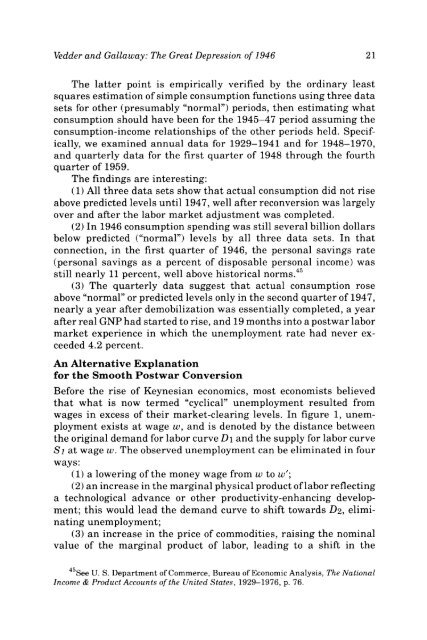Review of Austrian Economics - The Ludwig von Mises Institute
Review of Austrian Economics - The Ludwig von Mises Institute
Review of Austrian Economics - The Ludwig von Mises Institute
You also want an ePaper? Increase the reach of your titles
YUMPU automatically turns print PDFs into web optimized ePapers that Google loves.
Vedder and Gallaway: <strong>The</strong> Great Depression <strong>of</strong> 1946 21<br />
<strong>The</strong> latter point is empirically verified by the ordinary least<br />
squares estimation <strong>of</strong> simple consumption functions using three data<br />
sets for other (presumably "normal") periods, then estimating what<br />
consumption should have been for the 1945-47 period assuming the<br />
consumption-income relationships <strong>of</strong> the other periods held. Specifically,<br />
we examined annual data for 1929-1941 and for 1948-1970,<br />
and quarterly data for the first quarter <strong>of</strong> 1948 through the fourth<br />
quarter <strong>of</strong> 1959.<br />
<strong>The</strong> findings are interesting:<br />
(1) All three data sets show that actual consumption did not rise<br />
above predicted levels until 1947, well after reconversion was largely<br />
over and after the labor market adjustment was completed.<br />
(2) In 1946 consumption spending was still several billion dollars<br />
below predicted ("normal") levels by all three data sets. In that<br />
connection, in the first quarter <strong>of</strong> 1946, the personal savings rate<br />
(personal savings as a percent <strong>of</strong> disposable personal income) was<br />
still nearly 11 percent, well above historical norms. 45<br />
(3) <strong>The</strong> quarterly data suggest that actual consumption rose<br />
above "normal" or predicted levels only in the second quarter <strong>of</strong> 1947,<br />
nearly a year after demobilization was essentially completed, a year<br />
after real GNP had started to rise, and 19 months into a postwar labor<br />
market experience in which the unemployment rate had never exceeded<br />
4.2 percent.<br />
An Alternative Explanation<br />
for the Smooth Postwar Conversion<br />
Before the rise <strong>of</strong> Keynesian economics, most economists believed<br />
that what is now termed "cyclical" unemployment resulted from<br />
wages in excess <strong>of</strong> their market-clearing levels. In figure 1, unemployment<br />
exists at wage w, and is denoted by the distance between<br />
the original demand for labor curve D\ and the supply for labor curve<br />
Si at wage w. <strong>The</strong> observed unemployment can be eliminated in four<br />
ways:<br />
(1) a lowering <strong>of</strong> the money wage from w to w';<br />
(2) an increase in the marginal physical product <strong>of</strong> labor reflecting<br />
a technological advance or other productivity-enhancing development;<br />
this would lead the demand curve to shift towards D2, eliminating<br />
unemployment;<br />
(3) an increase in the price <strong>of</strong> commodities, raising the nominal<br />
value <strong>of</strong> the marginal product <strong>of</strong> labor, leading to a shift in the<br />
45 See U. S. Department <strong>of</strong> Commerce, Bureau <strong>of</strong> Economic Analysis, <strong>The</strong> National<br />
Income & Product Accounts <strong>of</strong> the United States, 1929-1976, p. 76.

















